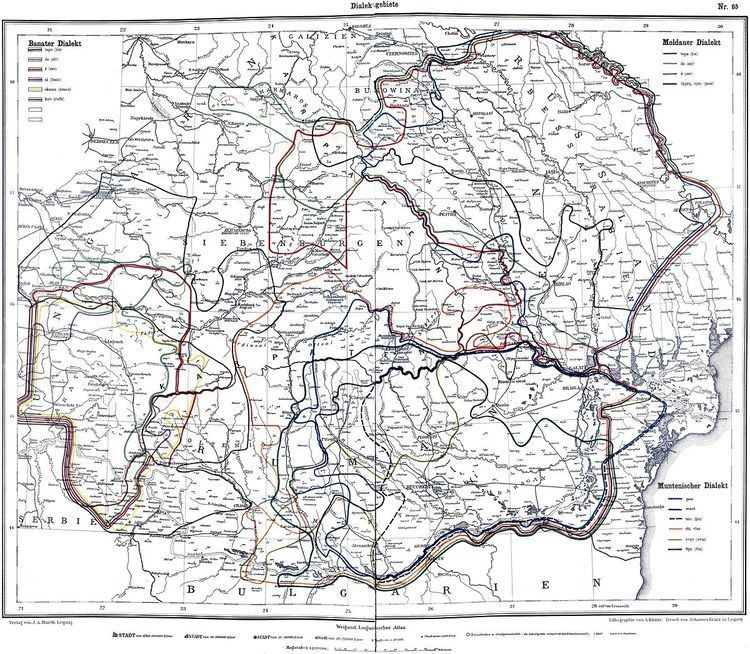 | ||
The Romanian dialects (subdialecte or graiuri) are the several varieties of the Romanian language (Daco-Romanian). The dialects are divided into two types, northern and southern, but further subdivisions are less clear, so the number of dialects varies between two and occasionally twenty. Most recent works seem to favor a number of three clear dialects, corresponding to the regions of Wallachia, Moldavia, and Banat (all of which actually extend into Transylvania), and an additional group of varieties covering the remainder of Transylvania, two of which are more clearly distinguished, in Crișana and Maramureș, that is, a total of five.
Contents
The main criteria used in their classification are the phonetic features. Of less importance are the morphological, syntactical, and lexical particularities, as they are too small to provide clear distinctions.
All Romanian dialects are at least somewhat mutually intelligible.
Terminology
The term dialect is sometimes avoided when speaking about the Daco-Romanian varieties, especially by Romanian linguists, who regard Daco-Romanian, Aromanian, Megleno-Romanian, and Istro-Romanian as "dialects" of a single Romanian language. It is partly from Romanian linguists having adopted the French and German usage of the term "dialect", as opposed to English-language usage.
In French and German, a dialecte/Dialekt refers to a closely related but separate language tightly linked, for cultural and historical reasons, to a certain language of reference. For instance, Scots would be a dialecte/Dialekt of English under the French and German meaning of the word, but it is not a dialect as it is understood in English.
Criteria
Early dialectal studies of Romanian tended to divide the language according to administrative regions, which in turn were usually based on historical provinces. This led sometimes to divisions into three varieties, Wallachian, Moldavian, and Transylvanian, or four, adding one for Banat. Such classifications came to be made obsolete by the later, more rigorous studies, based on a more thorough knowledge of linguistic facts.
The publication of a linguistic atlas of Romanian by Gustav Weigand in 1908 and later, in the interwar period, of a series of dialectal atlases by a team of Romanian linguists, containing detailed and systematic data gathered across the areas inhabited by Romanians, allowed researchers to elaborate more reliable dialectal descriptions of the language.
The criteria given the most weight in establishing the dialectal classification were the regular phonetic features, in particular phenomena such as palatalization, monophthongization, vowel changes, etc. Only secondarily were morphological particularities used, especially where the phonetic features proved to be insufficient. Lexical particularities were the least relied upon.
Phonetic criteria
Only the most systematic phonetic features have been considered in dialectal classifications, such as the following.
For ease of presentation, some of the phonetic features above are described by taking the standard Romanian pronunciation as reference, even though in dialectal characterizations such a reference is not necessary and etymologically speaking the process might have had the opposite direction. A criterion such as "closing of word-final [ə] to [ɨ]" should be understood to mean that some Romanian dialects have [ɨ] in word-final positions where others have [ə] (compare, for instance, Moldavian [ˈmamɨ] vs Wallachian [ˈmamə], both meaning "mother").
The most important phonetic process that helps in distinguishing the Romanian dialects concerns the consonants pronounced in standard Romanian as the affricates [t͡ʃ] and [d͡ʒ]:
Classification
The Romanian dialects have proven hard to classify and are highly debated. Various authors, considering various classification criteria, arrived at different classifications and divided the language into two to five dialects, but occasionally as many as twenty:
Most modern classifications divide the Romanian dialects into two types, southern and northern, further divided as follows:
